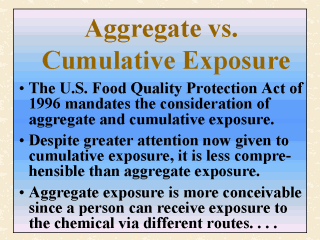| front |1 |2 |3 |4 |5 |6 |7 |8 |9 |10 |11 |12 |13 |14 |15 |16 |17 |18 |19 |20 |21 |22 |23 |24 |review |
 |
In the United
States, the Food Quality Protection Act of 1996 mandates the consideration of aggregate
and cumulative exposures. As mentioned in Lecture 7, aggregate doses are defined by the
exposure assessment community as those accumulated from multiple exposure pathways and
media, whereas cumulative doses are referred to as (the total of) all those aggregate
doses from exposures to multiple chemicals having a common mechanism of toxicity. Despite a great deal of regulatory attention now given to cumulative exposure, it is an assessment concept less comprehensible than aggregate exposure. Except for a small group of chemicals like organophosphates (OP), it is difficult to prove that two chemicals would undergo the same exact mechanism of toxicity. For instance, both malathion and diazinon are OP presumed to be capable of inhibiting the enzyme cholinesterase (ChE) to cause fatal effects. Diazinon can be broken down to thiopyrophosphate and diazoxon metabolites which are considered to be highly potent ChE inhibitors. Yet in mammals including humans, under normal conditions malathion is readily detoxified to the mono- and di-carboxylic acid metabolites which are not ChE inhibitors. The point being made here is that although both of these chemicals are capable of inducing the same adverse effects, their potencies are different and hence the exposures to them may not be additive or lumped. Nonetheless, it is quite conceivable that a person could receive the exposure to the same chemical via different routes or pathways within the same time period. |